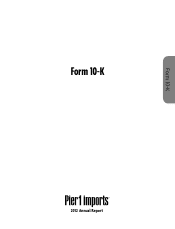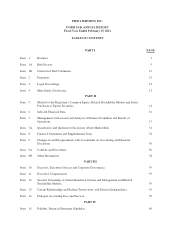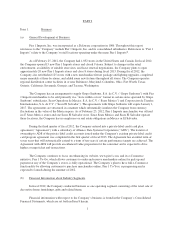Pier 1 2012 Annual Report Download - page 15
Download and view the complete annual report
Please find page 15 of the 2012 Pier 1 annual report below. You can navigate through the pages in the report by either clicking on the pages listed below, or by using the keyword search tool below to find specific information within the annual report.The Company outsources certain business processes to third-party vendors and has certain business
relationships that subject the Company to risks, including disruptions in business and increased costs.
The Company outsources some business processes to third parties including gift card tracking and
authorization, credit card authorization and processing, store scheduling and time and attendance, insurance
claims processing, U.S. customs filings and reporting, ocean freight processing, certain payroll processing and
tax filings, and record keeping for retirement plans. In addition, the Company also has business relationships
with third parties to provide essential services such as the extension of credit to its customers and maintenance of
the Company’s rewards program, and the Company is establishing many new vendor relationships to support its
e-Commerce growth initiatives. The Company makes a diligent effort to ensure that all providers of these
services are observing proper internal control practices, such as redundant processing facilities; however, there
are no guarantees that failures will not occur. Failure of third parties to provide adequate services or the
Company’s inability to arrange for alternative providers on favorable terms in a timely manner could have a
negative effect on the Company’s financial results.
Factors that may or may not be controllable by the Company may negatively affect the Company’s
financial results.
Increases in the Company’s expenses that are beyond the Company’s control including items such as
increases in fuel and transportation costs, higher interest rates, increases in losses from damaged merchandise,
inflation, fluctuations in foreign currency rates, higher costs of labor, labor disputes around the world, increases
in insurance and healthcare, increases in postage and media costs, higher tax rates and changes in laws and
regulations, including accounting standards, may negatively impact the Company’s financial results.
Failure to successfully manage and execute the Company’s marketing initiatives could have a negative
impact on the business.
The success and growth of the Company is partially dependent on generating customer traffic in order to
gain sales momentum in its stores and drive traffic to the Company’s website. Successful marketing efforts
require the ability to reach customers through their desired mode of communication utilizing various media
outlets. Media placement decisions are generally made months in advance of the scheduled release date. The
Company’s inability to accurately predict its consumers’ preferences, to utilize the desired mode of
communication, or to ensure availability of advertised products may negatively impact the business and
operating results.
Changes to estimates related to the Company’s property and equipment, or financial results that are
lower than its current estimates at certain store locations, may cause the Company to incur impairment charges
on certain long-lived assets.
The Company makes certain estimates and projections with regards to individual store operations as well
as overall Company performance in connection with its impairment analyses for long-lived assets in accordance
with applicable accounting guidance. An impairment charge is required when the carrying value of the asset
exceeds the estimated fair value or undiscounted future cash flows of the asset. The projection of future cash
flows used in this analysis requires the use of judgment and a number of estimates and projections of future
operating results. If actual results differ from the Company’s estimates, additional charges for asset impairments
may be required in the future. If impairment charges are significant, the Company’s financial results could be
negatively affected.
7
























